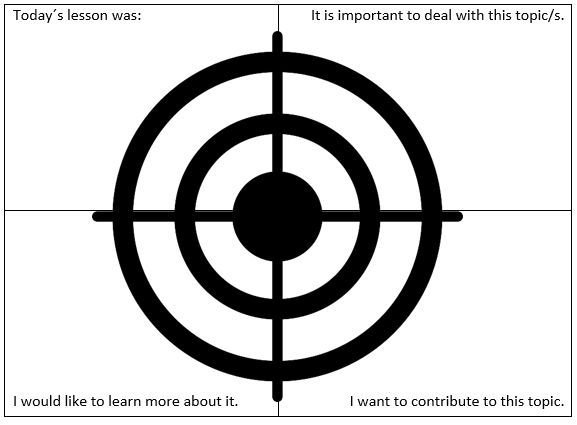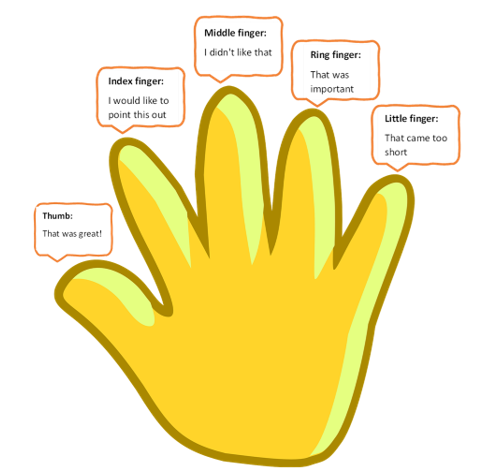4 Participation
4.3 Participatory exercises on different levels
Here are some ideas and examples of methods you can use to train your pupils' participatory skills according to Arnstein's 'Ladder of Citizen Participation':
In this context, we skip step 1 and 2, as they do not allow for real participation.
Step 3 – Informing
The teacher prepares an activity and sets the rules. He or she informs the pupils what it is about and what they can contribute. Most activities in class work like this.
Step 4 - Consultation
Pupils can express own ideas, wishes or criticism. How this gets implemented, however, is decided by the teacher.
Examples: Different methods of pupils´ feedback, like Learning diary, Flashlight, Bull's-eye, or Feedback Hand.
Bull's-eye: The pupils tick one point in each of the four areas for how much they agree.

Bull´s-Eye (Microsoft online images, Creative Commons, edited by Susanne Linde)
Feedback-Hand: Handout to give feedback to the lesson ...
 Feedback-Hand (Microsoft online images, Creative Commons, edited by Susanne Linde)
Feedback-Hand (Microsoft online images, Creative Commons, edited by Susanne Linde)
|
Thumb: |
|
|
|
|
|
Index Finger: |
|
|
|
|
|
Middle Finger: |
|
|
|
|
|
Ring Finger: |
|
|
|
|
|
Little Finger: |
|
|
|
|
Step 5 – Placation
Pupils are invited to plan activities and can make suggestions. The teacher takes these suggestions into account when making decisions.
Examples:
The pupils are asked where they would like to spend their next ski week or are allowed to help plan an excursion.
Idea-Box: Pupils can write their suggestions ideas and also topics they want to discuss on a sheet of paper (with their names or anonymously), and put this into a box, which is emptied and read out regularly, for example to prepare a class council.
Step 6 – Partnership
The teacher presents an idea for an activity to the class and invites the pupils to shape and implement it together with him or her.
Examples:
Theater play like the historical episodes
ACT-Game, Level 1
Planning and organisation of an Exhibition of Pupils´ works
Creation of a School magazine
Step 7 - Delegated Power
In this form, the idea or initiative comes from your pupils. They make the necessary decisions themselves and you only support them in the realisation of the idea.
Example:
Planning and organisation of school-activities or events, like School prom
Act-Game, Level 3
Step 8 - Citizen Control
The pupils realise their ideas completely independently and self-organised.
Participation in school is understood in the pedagogical context as the participation of pupils in all decisions relevant to them within the learning and living space of school. The opportunities for participation are oriented towards age-appropriate offers to take responsibility and grant autonomy (Reicher, 2017). For the philosopher John Dewey, schools have the task of teaching society in a way that is appropriate for children. This includes, among other things, education in a sense of responsibility and critical faculties (Dewey, 2008, cited in Konrad & Knoll, 2018). Democracy also means being able to lead a self-directed life; this must therefore also be anchored in education and in living together in the community (Dewey, 2008). The practice of democratic and solidary behaviour should be accompanied by teachers who are guided by the values of freedom and self-development and who advocate a social democracy of equality (Dewey, 2008).
The learning culture is shaped by democratic values and forms of communication based on equality. Ideally, the people in the learning space school are given a variety of opportunities to participate, have a say and help shape significant tasks. Opportunities for active involvement and participation of learners in the classroom are offered, for example, by areas of responsibility in classroom management, democratic bodies within the class community such as the class council, peer mediation and conflict mediation, as well as self-direction in the learning process by the pupils.
In addition, however, school democracy is also seen as an essential factor within the school culture; the learners should experience social manners and democracy through collaborative design of the learning space. Therefore, it is essential that the school culture as a whole, and not only the classroom teaching, functions as a model for learning experiences. If appreciation, experience of solidarity and social recognition are denied by the institution of school itself or by individuals, the learning of democracy (also in the classroom) will fail.
Here, the school management can support by creating recognised participation structures for pupils co-determination (e.g. pupils parliament, class representatives...), whereby this body for co-determination should represent a reflection of the diversity of the composition of all groups of people in school life. The members of this body should be elected in a fair, transparent election process and this participation body should be recognised as a fully-fledged part of the opinion-forming process. Furthermore, processes should be defined to ensure that participation is possible regardless of gender, ethnicity, impairment, etc. Last but not least, realistic and meaningful fields of activity for co-determination and co-design of school life are of course needed.
The positive, democratic shaping of the school climate shows interactions with the well-being of learners and teachers. Results from school research also show that indirect value formation via a democratic-participative school culture has a positive effect on violence prevention in schools (Schubarth et al., 2017). Motivation and perceived meaningfulness can thus be increased and stress factors reduced. These connections between school success and participation opportunities can be proven (Schroll, 2016).